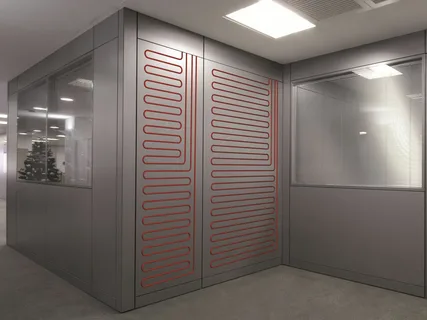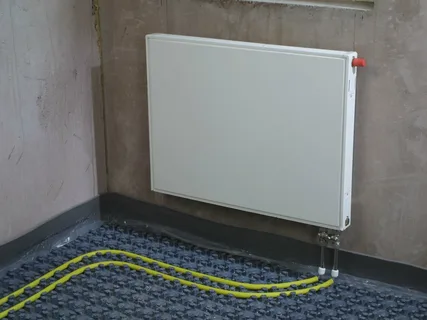In indoor heating solutions, radiant panels have emerged as a game-changer, offering a sophisticated alternative to traditional heating methods. Unlike conventional systems that rely on circulating heated air or water, radiant panels utilize infrared radiation to efficiently warm spaces. This innovative technology enhances comfort, promotes energy efficiency, and improves indoor air quality. Radiant heat panels represent a modern and creative approach to indoor heating, offering significant advantages over traditional heating methods like forced-air systems or radiators. Utilizing infrared radiation, these panels distribute warmth evenly across a space, ensuring comfort while being energy-efficient.
What are Radiant Panels and How Do They Work?
Imagine walking into your cozy home on a chilly winter morning, feeling the warmth envelop you, and knowing that you’re surrounded by a gentle, soothing heat that seeps deep into your bones. It is the magic of radiant panels, a revolutionary heating solution that’s taking the world of home comfort by storm. But what exactly are radiant panels, and how do they work their wonders?
Simply put, radiant panels are sleek, modern heating systems that use infrared radiation to warm objects and people rather than air heating. This innovative approach allows for a more efficient, cost-effective, and environmentally friendly way to keep your home warm and cozy. Unlike traditional heating systems, which can dry out the air and create hot spots, radiant panels distribute heat evenly, providing a consistent and comfortable warmth perfect for any room in your home.
Radiant panels convert electrical energy into gentle infrared heat, creating a warm and welcoming atmosphere that’s hard to resist. They operate by emitting infrared radiation, which directly heats objects and people in the room without heating the air. This process mimics the sun’s natural warmth, creating a comfortable environment that avoids the dryness and uneven temperatures often associated with forced-air systems.
 Radiant Panels: Considerations before Installation
Radiant Panels: Considerations before Installation
Before installing radiant panels, several key considerations should be carefully evaluated to ensure optimal performance and efficiency. Firstly, assessing the building’s insulation is crucial. Effective insulation minimizes heat loss, enhancing the effectiveness of radiant panels in maintaining desired indoor temperatures. Additionally, the type of flooring above which the panels will be installed plays a significant role. Materials such as tile and concrete are excellent conductors of heat, making them ideal for use with radiant panels, whereas thick carpets can insulate and reduce heat transfer efficiency.
Moreover, the system’s design and layout are critical factors. Proper spacing and positioning of panels ensure uniform heat distribution throughout the space. Calculating heat load requirements based on room dimensions, insulation levels, and local climate conditions is essential to determine the number and size of panels needed for each area.
Furthermore, the compatibility of radiant panels with existing heating systems should be considered. Integration with conventional HVAC systems or alternative renewable energy sources can optimize energy efficiency and overall cost-effectiveness.
Benefits of Radiant Panels: Why they’re a Game-Changer for Home Comfort
Radiant panels are a game-changer for home comfort, offering many benefits that make them a highly sought-after heating solution.
Here are just a few of the advantages of incorporating radiant panels into your home:
- Energy Efficiency: Radiant panels are incredibly energy-efficient, converting up to 95% of their electrical energy into usable heat. It means you can enjoy warm and cozy spaces while keeping your energy bills in check.
- Even Heating: Unlike traditional heating systems, which can leave cold spots and drafts, radiant panels provide even, consistent heat that permeates every corner of your home.
- Allergy Sufferers Rejoice: Because radiant panels don’t circulate air, they don’t stir up allergens and dust, making them a perfect solution for those who suffer from allergies or respiratory issues.
- Space-Saving Design: Radiant panels are sleek and slim, occupying minimal space in your home. They can be easily mounted on walls or ceilings, freeing up valuable floor space.
- Low Maintenance: Radiant panels require little to no maintenance, as they have no moving parts and don’t need to be cleaned or replaced regularly.
- Improved Air Quality: By not circulating air, radiant panels don’t dry out the air, leading to improved air quality and a healthier breathing environment.
- Silent Operation: Unlike noisy traditional heating systems, radiant panels operate silently, providing a peaceful and comfortable heating experience.
With these benefits, it’s no wonder why radiant panels are becoming popular for homeowners seeking to upgrade their comfort.
Types of Radiant Panels: Choosing the Right One for Your Home
The options can be overwhelming when selecting the perfect radiant panel for your home. With various types of radiant panels available, each offering unique benefits and characteristics, it’s essential to understand their differences. Electric radiant panels, for instance, are a popular choice for their ease of installation and energy efficiency.
They are perfect for small to medium-sized spaces and can be easily mounted on walls or ceilings. Hydronic radiant panels use hot water to warm up your space, providing a more consistent and gentle heat. These panels are ideal for larger areas and can be integrated with your heating system.
Infrared radiant panels, which use infrared radiation to warm objects and people, are another option, offering a quick and efficient way to heat a room. There are also hybrid radiant panels combining different heating technologies to provide a customized heating solution. By understanding the unique features and benefits of each radiant panel type, you can make an informed decision and choose the one that best suits your home’s specific needs and personal comfort preferences.
Installation Options and Considerations
When installing radiant panels in your home, there are several options to consider, each with its unique benefits and challenges. One of the most popular installation methods is to mount the panels on walls or ceilings, allowing for a sleek and modern aesthetic. This approach is ideal for open-plan living spaces or rooms with high ceilings, where the panels can be showcased as a design feature.
Alternatively, radiant panels can be installed on floors, providing a discreet and efficient heating solution. This option is particularly well-suited for bathrooms, kitchens, and other areas with limited floor space. Additionally, radiant panels can be installed in ceilings with suspended grids, making them a great option for offices, commercial spaces, or homes with drop ceilings.
Regardless of the installation method chosen, factors such as panel size, spacing, and electrical connections must be considered to ensure safe and efficient operation. By carefully planning and executing the installation, you can enjoy the warmth, comfort, and energy efficiency that radiant panels offer.
Tips for Getting the Most Out of Your Radiant Panels
As you embark on the journey to warm up your home with radiant panels, it’s essential to remember a few key tips to ensure you get the most out of your investment. Here are the valuable tips to help you maximize the comfort and efficiency of your radiant panels:
- Optimize Panel Placement: Strategically place your radiant panels in areas where you need warmth the most, such as near windows, doors, or areas with high foot traffic.
- Insulate, Insulate, Insulate: Proper insulation is crucial to ensure the heat from your radiant panels is not lost. Ensure you insulate your floors, walls, and ceilings to keep the warmth in.
- Choose the Right Wattage: Select radiant panels with the right wattage for your space. A higher wattage panel may be necessary for larger areas or areas with high heat loss.
- Combine with Other Heating Sources: Radiant panels can be used in conjunction with other heating sources, such as traditional HVAC systems, to create an efficient and effective hybrid heating system.
- Maintain a Comfortable Temperature: Set your thermostat to a comfortable temperature, and let your radiant panels rest. It will help you avoid overheating and reduce energy consumption.
- Use a Programmable Thermostat: A programmable thermostat allows you to schedule your heating needs, ensuring your radiant panels are only used when needed, saving you energy and money.
- Regularly clean and maintain Your Panels: Dust and dirt can reduce the efficiency of your radiant panels. Regularly clean and maintain your panels to ensure they continue to provide optimal heat and comfort.
How Radiant Panels Work
Imagine stepping into a warm and cozy room where the gentle heat envelops you, melting away the chill and stress of the day. This is the magic of radiant panels, a revolutionary heating solution that’s transforming the way we experience comfort in our homes. But how do these wonders work? The answer lies in the science of radiant heat. Radiant panels use infrared radiation to warm objects and people rather than heating the air.
It is a more efficient and effective way to heat, as it directly targets the areas that need warmth rather than wasting energy on heating the surrounding air. The panels are usually installed in ceilings or walls, and they emit a gentle, soothing heat that’s evenly distributed throughout the room. It means that you can enjoy a consistent and comfortable temperature without the drafts and hot spots that come with traditional heating systems. As the heat is radiated directly to you, you’ll feel cozy and warm, even at a lower temperature setting, making it a more energy-efficient and cost-effective option for your home.
Advantages of Radiant Heat Panels
You’re enveloped in a warm, comforting embrace as you step into your cozy home. The chill of the outside world melts away, replaced by a sense of relaxation and serenity. The magic of heat panels, a game-changing technology, is revolutionizing how we heat our homes. One of the most significant advantages of radiant heat panels is their ability to provide consistent, even heat distribution.
Unlike traditional forced-air systems, which can leave hot spots and cold drafts, heat panels warm your home from the floor up, ensuring that every corner of your space is cozy and comfortable. Additionally, heat panels are incredibly energy-efficient, using up to 30% less energy than traditional heating systems.
It means you can enjoy the warmth and comfort you crave while keeping your energy bills in check. And, with their sleek and slim design, heat panels can be easily installed in any room, providing a seamless and discreet heating solution that won’t compromise your home’s aesthetic. Heat panels heating objects and individuals directly reduce energy wastage associated with heating unused air space. Unlike forced-air systems, which can create drafts and uneven heating, radiant panels provide consistent warmth across the room.
Conclusion
As you’ve learned throughout this guide, radiant panels are a game-changer for homeowners seeking comfort, efficiency, and style. By incorporating these innovative heating solutions into your home, you’ll enjoy a warm, cozy, inviting atmosphere perfect for relaxing and unwinding after a long day. Whether you’re looking to upgrade your existing heating system or install a new one, radiant heat panels offer a unique blend of benefits that set them apart from traditional heating methods. With their sleek design, energy efficiency, and versatility, it’s no wonder why radiant panels are becoming an increasingly popular choice for homeowners.
FAQS
Q: Are Radiant Panels Expensive To Install?
A: While the initial installation cost may be higher than traditional heating methods, radiant panels can provide long-term savings through energy efficiency and reduced maintenance costs.
Q: Can Radiant Panels Be Used In Conjunction With Other Heating Systems?
A: Radiant panels can be easily integrated with existing heating systems to provide a comprehensive and efficient heating solution.
Q: Are Radiant Panels Safe To Use?
A: Absolutely! Radiant panels are designed with safety in mind, featuring built-in safety features and automatic shut-off mechanisms to ensure safe and worry-free operation.
| Other Good Articles to Read |
| skank blogs |
| unreal blogs |
| tba blogs |
| all city forums |
| dany blogs |
| the music blogs |
| key forums |
| the big blog theory |
| joe blogs |
| blogs 4 me |
| Blogs Emon |
| Related Business Listings |
| Contact Directory |
| Local Business Profiles |



